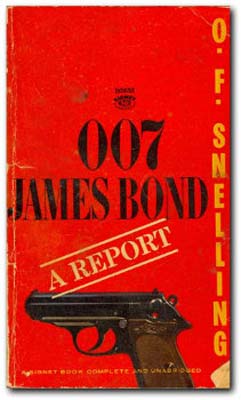
HOMEWesley Britton’s Books,
|
Spies on FilmSpies on Television & RadioSpies in History & LiteratureThe James Bond Files |
|
The James Bond Files ~ The O.F. Snelling 007 Archives
Introductory Notes by Wesley Britton 
The original cover of 007 James Bond – A Report, by O.F. Snelling According to an unpublished manuscript by O. F. Snelling, “It was my agent and friend, Mr. Ronald Payne,” who suggested that a new, revised hardcopy version of Double 0 Seven: James Bond, A Report should be issued. This book, originally published in Great Britain in 1964, within a matter of days after Ian Fleming died, was “the very first book-length study of the already world-famous James Bond character. It did surprisingly well. In Britain it was reprinted in paperback by Panther Books, it appeared in French, Dutch, Portuguese, Japanese, and Israeli editions and translations, and it came out in the United States in 1965 under the imprint of the New American Library, Ian Fleming’s own publishers. There, for a short time it topped the best-seller lists. I have assessed that this book must have sold well over one million copies throughout the world.” Those readers of the original paperback experienced Oswald Frederick Snelling’s literary critique of the Bond novels in five sections. First, Snelling examined “His Predecessors”, “those upper-crust fictional heroes who performed feats of sexless derring-do long before the advent of the permissive society: leftover puppets from the age of chivalry.” “His Image” was a section which analyzed “James Bond personally in the minutest detail, from the black comma of hair which falls across his brow to the casual shoes he wears on his feet.” “His Women,” as the reviewers noticed, “is the longest part. The girls are most certainly worth examining, and this chapter attracted a lot of attention and comment. Then comes ‘His Adversaries.’: these are villains like LeChiffre, Dr. No, Mr. Big, and of course, the infamous Ernst Stavro Blofeld. Finally, ‘His Future.’” In Snelling’s view, this was bright indeed for 007. The final page was a reproduction of a now famous watermark he saw on his typing paper – “Bond-Extra Strong.” Fifteen years after the first printing, Snelling added, “Since the year 1964 a whole new generation of readers has grown up and emerged. (Indeed, I still receive the occasional fan letter from the states, and the writers of these letters are invariably between sixteen and twenty years of age.) Many members of this particular generation are first being introduced to James Bond by Cubby Broccoli’s amazingly successful sequence of films about this character, exemplified in the persons of Sean Connery, George Lazenby and Roger Moore. Thrilled, titillated, and ‘influenced’ by the exploits of Bond, by his opponents, and by the many lovely girls in the films seen on the large screens of the drive-ins, the smaller screens of the conventional movie-houses, and the domestic screens of home television, they turn to and seek out the Ian Fleming books. Here, if they are sufficiently fortunate to find them, they discover an entirely ‘new’ James Bond. I employ the quotation marks advisedly. He is a new James Bond to them.” Throughout his life, Snelling clearly preferred the literary 007 he wrote about in his book to the film incarnations that had just begun when Double O Seven was published. “The Bond of the ‘sixties and ‘seventies films is a handsome, swashbuckling, wisecracking secret agent following in the same tradition of Douglas Fairbanks of the ‘twenties and Errol Flynn of the ‘thirties and ‘forties. In a film of something around two hours in length there is no time for subtle character-drawing. Neither is there any need or intention of this. All the original plots have been altered anyway. Now, practically all we have left is the name of the protagonist, the title of the book which has been adapted, and the man’s perennial occupation of secret agent. But reading book after book, in the sequence in which they were written, James Bond emerges to the youngsters as the ‘livingest’ hero in twentieth century sensational fiction. We get to know his particular predilections, his habits, his fads and his fancies, the sort of women he likes, and the many things he most certainly dislikes.” In these 1980 notes written long before Snelling died on January 31, 2001 in London, the writer concluded by describing his now classic critical study: “‘Double 0 Seven’ set out to examine and to analyze James Bond by treating him as a real person. It was not a long book, and it made no attempt to be highbrow, abstruse, or involved. It was deliberately written in a racy and easy-to-read style. Certainly it is jokey and humorous, but it is both lighthearted and serious at the same time.” As it happened, Snelling’s book was released just after Fleming’s 1964 You Only Live Twice appeared, and references to this grim novel were added as footnotes. Snelling’s study also preceded Fleming’s posthumous Man With the Golden Gun and short story collection entitled Octopussy. So Snelling’s notes were intended to serve as a Preface to an updated, revised publication based on the 1964 volume. Naturally, describing what he hoped for in a new release, Snelling said, “In the proposed new and revised edition I would deal to some extent with the last two books and the characters therein. I envisage the inclusion of a preface telling the story of the book’s publishing history, which I think is rather amusing. I would also add a further section, possibly, entitled ‘His Films.’ It is a point worth remembering that practically the whole of Fleming’s output has now reached the screen, if only in the broadest sense. There is very little left to adapt, and very shortly Roger Moore, Sean Connery, and any new and fortunate actor who might be chosen to play this role will be faced with original titles and screen plays. The moguls are not going to give up on so lucrative a property as James Bond just because they have run out of Fleming books.” Truer words were never spoken. In subsequent years, Snelling’s literary executor, Ronald Payne, has continued to hope a new edition will ultimately be released and talks with potential publishers continue. Until then, Ron Payne has generously permitted this electronic publication of these “O. F. Snelling Archives”, which include:
It’s important to note that this project is ongoing and organic. For one matter, Ron has many more letters in his possession to sort through. The first posting here (May 2007) includes material boiled down from but a small portion of Ron’s files. Many years of correspondence are not yet represented here. In addition, many letters are now difficult to transcribe and work with short of retyping them. So additions will appear as supplements as Ron works through his collection. And, while not directly related to Mr. Bond, we also offer the first online publication of an essay Snelling wrote for the Antiquarian Book Monthly Review in 1981. This discussion of “Clubland” writer Dornford Yates was seen only by subscribers to that magazine, and never available in America. (Yates, as mentioned in James Bond Under the Microscope, was very much a literary forbearer to Ian Fleming.) Ron and I both hope the new edition of James Bond Under the Microscope and the letters will be interesting reading on their own – and will perhaps whet some publisher’s appetite to bring out the long delayed re-issue of a unique and erudite look into the world of 007. For a detailed obituary of O. F. Snelling, refer to The Independent Online Edition – 30 January 2002. |